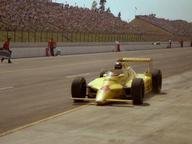Quiz Answer Key and Fun Facts
1. In Brazil it is customary to give a child the surname of both mother and father. When Ayrton was setting his first steps as a racing driver he chose only to use his mother's name. What was his father's surname?
2. Ayrton competed in his first kart race when he was only eight years old. It was a friendly race, and the starting order was determined by luck of the draw. Where did he, ominously, start in his first race?
3. When Ayrton was racing in the Formula Ford championships in England he shared living quarters with another Brazilian racing driver who would make it into Formula 1. Who is this?
4. In 1983 Ayrton raced in the British Formula 3 series. Despite an excellent start to the season he had to wait until the final race to win the championship. Who was his main opponent that season who finished second in the series?
5. Ayrton had his first chance at success in the 1984 Monaco Grand Prix. The narrow track and the rain allowed his natural talent to shine through and compensate the shortcomings of his car. By lap 31 he was in second place, rapidly closing in on leader Prost. What was the outcome of the race?
6. Ayrton went to Lotus for the 1985 season. In the second race for his new team he won his first race. Unsurprisingly it was a wet race. Where did he win his first F1 race?
7. Williams was the dominant team in the 1986 season. Ayrton managed to beat Williams driver Mansell in the Spanish Grand Prix. What was the margin between these two drivers at the end of the race?
8. Ayrton stayed at Lotus for the 1987 season. He hoped the team's new engine supplier would give him a better chance at becoming world champion. Which engine supplier was this?
9. Ayrton completely dominated the 1988 Monaco Grand Prix. Even with a 50 second advantage over teammate Prost he kept setting fastest laps. What was the outcome of that race for Senna?
10. If Ayrton won the 1988 Japanese Grand Prix he would achieve his life's ambition and become Formula 1 world champion. It could have been an easy victory but there was a problem that made his task all the more difficult. What happened?
Source: Author
AlonsoKing
This quiz was reviewed by FunTrivia editor
gtho4 before going online.
Any errors found in FunTrivia content are routinely corrected through our feedback system.
